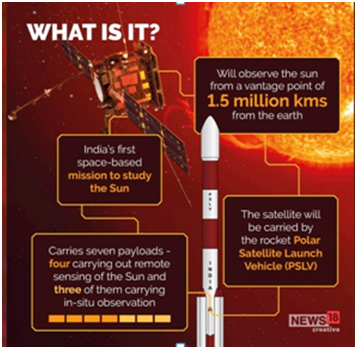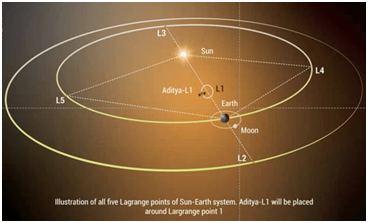Why in News?
- ISRO updated that a Trajectory Correction Maneuver (TCM) was performed on India’s first solar mission Aditya L1.
What’s in Today’s Article?
- About Aditya L1 Mission (Specifications, Route, Objectives, Lagrange Points, Halo Orbit, etc.)
- News Summary
About Aditya L1 Mission:

- 'Aditya' literally means the Sun in Sanskrit.
- ISRO’s Aditya L1 mission is India's first space-based mission to study the Sun. It was launched from the Satish Dhawan Space Centre on 2nd September, 2023.
- Aditya-L1 will first be placed in a low earth orbit by ISRO's PSLV-C57 launch vehicle.
- After that, the spacecraft's orbit will be made more elliptical.
- On-board propulsion will be used to launch the spacecraft towards L1 point.
- As it moves towards L1, the spacecraft will exit Earth's gravitational Sphere of Influence (SOI).
- After it exits the SOI, the spacecraft will begin its cruise phase.
- The mission will take around 109 Earth days after launch to reach the halo orbit around the L1 point, which is about 1,500,000 km from Earth.
What are the Objectives of the Aditya L1?
- The mission's main objective is to expand our knowledge of the Sun, and how its radiation, heat, flow of particles, and magnetic fields affect us.
- Below is the list of other objectives that the mission will embark upon:
- To study the upper atmospheric layers of the Sun called chromosphere and corona. While the corona is the outermost layer, the chromosphere is just below it.
- To examine coronal mass ejections (CMEs), which are large expulsions of plasma and magnetic fields from the Sun's corona.
- To analyse the corona's magnetic field and the driver of the space weather.
- To understand why the Sun's not-so-bright corona is a million degree Celsius hot when the temperature on the surface of the Sun is just about 5,500 degrees Celsius.
- To help scientists know the reasons behind the acceleration of particles on the Sun, which leads to the solar wind - the constant flow of particles from the Sun.
What are the Lagrange Points?

- There are five Lagrange points, L1 to L5, between any two-celestial body system.
- At these positions, the gravitational pull of the celestial bodies equals the centripetal force required to keep a smaller third body in orbit.
- In simpler words, the forces acting on the third body cancel each other out.
- The points can be used as ‘parking spots’ for spacecraft in space to remain in a fixed position with minimal fuel consumption, according to NASA.
- They have been named after Italian-French mathematician Joseph-Louis Lagrange (1736-1813), who was the first one to find the positions.
- So, between the Earth and the Sun, a satellite can occupy any of five Lagrangian points.
What is a Halo Orbit?
- NASA says a spacecraft can “orbit” about an unstable Lagrange point with a minimum use of thrusters for stationkeeping.
- Such an orbit is known as a halo orbit as “it appears as an ellipse floating over the planet”.
- A halo orbit, however, isn’t the usual orbit because the unstable Lagrange point doesn’t exert any attractive force on its own.
Why will Aditya Spacecraft go around L1 Point?
- It’s because L1 gets a continuous and unhindered view of the Sun.
- L2 is located behind the Earth, and thus obstructs the view of the Sun, while L3 is behind the Sun which is not a great position to communicate with Earth.
- L4 and L5 are good and stable locations but are much farther from Earth compared to L1, which is directly between the Sun and the Earth.
- The European Space Agency’s (ESA) Solar and Heliospheric Observatory spacecraft (SOHO) is also stationed at a halo orbit around the L1 point of the Earth-Sun system.
- The spacecraft has been operational since 1996 and has discovered more than 400 comets, studied the outer layers of the Sun and examined solar winds.
Significance/Need of Studying Sun from Space:
- According to ISRO, the Sun emits radiation/light in nearly all wavelengths along with various energetic particles and magnetic fields.
- The atmosphere of the Earth as well as its magnetic field acts as a protective shield and blocks a number of harmful wavelength radiations including particles and fields.
- This means studying the Sun from Earth can’t provide a complete picture and it becomes crucial to observations from outside the planet’s atmosphere i.e., from space.
News Summary:
- ISRO updated that a Trajectory Correction Maneuver (TCM) was performed on India’s first solar mission Aditya L1.
- The spacecraft propulsion system was fired for 16 seconds on October 6 to correct its trajectory towards the L1 point.
- The space agency said that the manoeuvre“was needed” to correct the trajectory of the spacecraft was evaluated after it was inserted in the path towards the L1 point on September 19.
- The spacecraft left the Earth’s sphere of influence eight days ago — the second spacecraft by the Indian space agency after Mangalyaan that has left the Earth’s sphere of influence.









